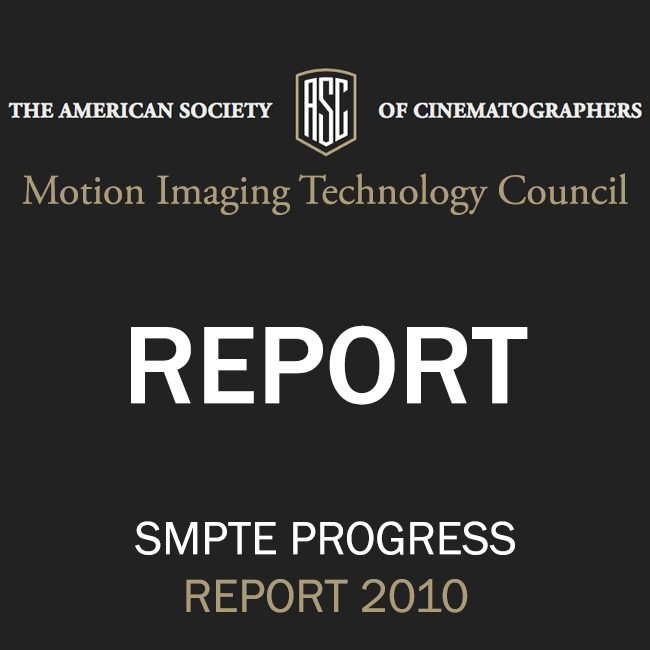Report Authors
Curtis Clark, ASC; David Reisner; David
Stump, ASC; Ron Garcia, ASC; Lou Levinson;
Al Barton; Ron Burdett; Bill Feightner; Gary
Demos; Don Eklund; Eric Rodli; Steve Schklair;
Garrett Smith; John Scheele; David Morin
ASC Technology Committee
Officers
Chair: Curtis Clark, ASC
Vice-Chair: Richard Edlund, ASC
Vice-Chair: Steven Poster, ASC
Secretary: David Reisner, D-Cinema Consulting
Since the inception of our ASC Technology Committee in 2003 we
have been continuously and actively engaged with the emergence and
evolution of digital imaging technologies, beginning with Digital Intermediate (DI) and its relentless march to becoming the pervasive
post finishing environment. In fact, our Technology Committee has
been continuously and integrally involved with key major phases of
the paradigm shift from predominantly analog to increasingly digital
imaging technologies. Having successfully collaborated with DCI to
produce the crucial StEM test footage which contributed to the creation of the current digital cinema standards, we then partnered with
the PGA to produce the Camera Assessment Series (CAS) which was
designed to assess the capability of the seven leading digital motion
picture cameras to effectively compete with film origination. As always, a fundamental objective of our Committee is to understand how
technology developments, both digital and analog, affect the cinematographer’s ability, working in collaboration with a director, production designer and VFX supervisor, to realize a photographic vision.
Much of our 2009 ASC Technology Committee report was focused
on the intensely challenging, but immensely important work of our
Camera Assessment Series. Digital motion picture camera manufacturers who participated in CAS have gained invaluable experience
regarding the imaging strengths and weaknesses of their respective
cameras and the dependence of digital camera imaging performance
on Digital Intermediate workflow implementation.
As a result of that prolonged and painstaking effort, vital lessons
have been learned about the importance of understanding the limitations of current DI workflow practices, especially regarding their ability to achieve optimal imaging performance for digital motion
picture cameras, as well as film capture. As I said in my introduction
to our 2009 report, “The pressing issues concerning workflow color
management and the need for unambiguous transforms between
log, video “linear” (gamma), and scene referenced linear encoded
images have been intensified by the rapid adoption rate of digital
motion picture cameras for both feature and TV production.” Those
limitations, which include color bit depth, along with ambiguous
transforms between log encoding and scene linear are now being
successfully addressed in test bed implementations of workflows
based on the Academy of Motion Picture Arts & Sciences (AMPAS)
developed Image Interchange Framework (IIF)-Academy Color Encoding Specification (ACES).
The ASC, via our ASC Technology Committee, has fully endorsed
IIF-ACES as the “next generation” best practice successor to current
DI workflow practice and our Technology Committee is actively collaborating with the AMPAS Science & Technology Council to further
its development and encourage industry adoption. We believe that
IIF-ACES enables effective solutions that resolve current ambiguities
and impediments inherent in much of today’s DI workflow practices
which can inadvertently restrict optimal imaging performance, especially for the integration of live action with CGI VFX.
Also, our widely adopted ASC CDL is being further developed to become a key IIF-ACES Look Modification Transform (LMT). Development work is being led by our Digital Intermediate Subcommittee
and includes the additional implementation of a 6-axis (6-vector)
function that will facilitate separate RGB primary and YCM secondary color saturation controls. These additional functions will further reinforce the value of our ASC CDL as an effective cross-platform look management tool that is able to coordinate cinematographer look references for "on-set" dailies with VFX, as well as provide look reference starting points for final Digital Intermediate color grading.
The Subcommittee reports that follow, address various key issues
that our ASC Technology Committee will be focusing on during
the coming year, including the recent surge of 3D, as well as the
emergence of the “virtual camera” pioneered on Avatar. This “virtual production” workflow is being addressed by our newly formed
Joint Technology Subcommittee on Virtual Production that is collaboratively shared with the Art Directors Guild (ADG), Visual Effects Society (VES) and Producers Guild of America (PGA). Also, we have a report from the newly formed Previsualization Society which,
I am proud to say, is the outcome of a successful conclusion to our
ASC-ADG-VES Joint Technology Subcommittee on Previsualization.
We will also be tracking the emergence of the DSLR motion image
capture option.
The ASC Technology Committee will continue its mission to be a
leading motion picture industry forum that actively engages motion
imaging technology developments while addressing their impact on
the art of filmmaking.
Curtis Clark, ASC
ASC Technology Committee Chair
